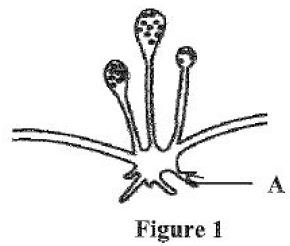Species with cellulose in their cells are formally placed in
- Kingdom Monera
- Kingdom Animalia
- Kingdom Fungi
- Kingdom Plantae
- Kingdom Protista
2
The best evidence that two organisms belong to the same species is that they:
- can breed with other organisms which are not of their kind
- live in the same habitat and have similar ways of nutrition
- produce fertile off-springs when interbred under natural conditions
- produce infertile off-springs when interbred.
3
The structures found in bacteria are A plasmid, flagella and cilia
- cytoplasm, cilia and pastids
- cell wall, plasmid and flagella
- cell membrane,
- flagella and hairs
- plasmid, capsule and cilia
4
The taxonomic category of organisms belonging to the same class but not the same family is:
- Species
- Genus
- Order
- Phylum
- Kingdom
5
The lowest rank of classification is called
- Class
- Kingdom
- Species
- Genus.
6
Which structure differentiates euglena from other members of the Kingdom Protista?
- Possession of flagellum
- Possession of chloroplast
- Possession of antennae
- Possession of cell wall
7
Which structure differentiates euglena from other members of the Kingdom Protista?
- Possession of flagellum
- Possession of chloroplast
- Possession of antennae
- Possession of cell wall
8
The correct hierarchical order of grouping organisms is:
A. Kingdom, Phylum, Class, Order, Family, Genus, Species.
B.Kingdom, Phylum, Order, Class, Family, Genus, Species.
C. Species, Genus, Family, Order, Class, Phylum, Kingdom.
D. Kingdom, Phylum, Class, Family, Order, Species, Genus.
Choose Answer :9
Organisms which move by means of flagella include:
- Paramecium and euglena
- Euglena and bacteria
- Bacteria and amoeba
- Amoeba and plasmodium
10
Which statement is true about the virus?
- It is active outside the host cell but dormant inside it
- It is active inside the host cell but dormant outside it
- It carries life processes when outside the host cell
- It has both DNA and RNA as genetic materials
11
One of the most distinctive features used to place organisms in the Kingdom Fungi is the presence of
- gill structures
- hyphae
- cellulose
- cap
- exoskeleton
12
Why are bats and birds not placed in the same species while they are closely related organisms? ...............
- They cannot interbreed to produce a fertile offspring
- They can interbreed to produce a fertile offspring
- One lays eggs and another can give birth
- One possesses feathers and another short beak.
13
13. With the aid of a well labelled diagram, describe the structure of bacteria and give three advantages and disadvantages of bacteria in daily life.
View Ans14
(a) Define the terms “classification” and “Taxonomy”.
(b) (i) List the types of classification systems.
(ii) Give two differences between the classification systems you have listed in (b)(i).
View Ans15
-
Explain two differences between artificial and natural classification systems and indicate the two merits and demerits for each system..
16
(i) List the five kingdoms into which orgamisms are placed.
(ii) List the distinctive features of members of the kingdom to which a malaria vector belongs.
View Ans17
(iv) Natural classification is based on evolutionary relationships……………….
View Ans18
Complete each of the following statements by writing the correct answer in the answer sheet provided.
(i) A taxonomic rank of organisms which interbreed freely and give rise to viable offspring are known as .........................
(ii) The type of classification which is based on few observed features is called .....
(iii)The highest rank of classification is known as ..........................
(iv) The process of sorting living things into groups is called .
(v) The process of giving organisms scientific names is known as .................
View Ans19
(a) List the major groups of living organisms. (Mention 5)
(b) Figure 1 represents an organism which feeds on dead organic matter. Study the diagram carefully then answer the questions that follow:

(i)What is the name of organisms in Figure 1?
(ii) Name the part labelled with letter A.
(iii) Mention the Phylum in which the organism you named in (a) (i) belongs.
(c) Outline two disadvantages of Kingdom Fungi.
View Ans20
(a) What is the difference between natural and artificial classifications?
(b) Explain why the artificial system of classification is not good.
(c) Mention two disadvantages of bacteria.
View Ans21
Define the following terms:
(i)Classification
(ii)Binomial nomenclature
View AnsHub App
 For Call,Sms&WhatsApp: 255769929722 / 255754805256
For Call,Sms&WhatsApp: 255769929722 / 255754805256
 For Call,Sms&WhatsApp: 255769929722 / 255754805256
For Call,Sms&WhatsApp: 255769929722 / 255754805256
WHATSAPP US NOW FOR ANY QUERY
App Ya Learning Hub Tanzania






